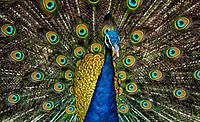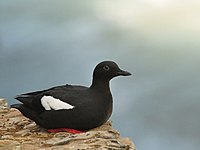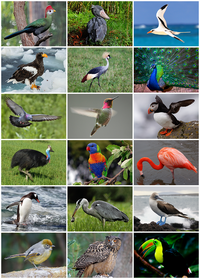
Production of plumage ornaments among males and females of two closely related tropical passerine bird species
Sign Up to like & getrecommendations! Published in 2017 at "Ecology and Evolution"
DOI: 10.1002/ece3.3000
Abstract: Abstract The evolution of elaborate secondary sexual traits (i.e., ornaments) is well‐studied in males but less so in females. Similarity in the appearance of ornaments between males and females supports the view that female ornaments… read more here.
Keywords: females two; production; closely related; males females ... See more keywords

White eye patches of female wood ducks, Aix sponsa, vary markedly in size and may reflect individual status or condition
Sign Up to like & getrecommendations! Published in 2020 at "Animal Behaviour"
DOI: 10.1016/j.anbehav.2020.06.023
Abstract: Research into plumage ornaments and plumage signals of individual state has focused primarily on males, while variation among females has received far less attention. White patches of plumage around the eye (eye patches) are a… read more here.
Keywords: eye patches; size; eye patch; eye ... See more keywords

Pigeons in the sun: Thermal constraints of eumelanic plumage in the rock pigeon (Columba livia).
Sign Up to like & getrecommendations! Published in 2020 at "Journal of thermal biology"
DOI: 10.1016/j.jtherbio.2020.102601
Abstract: In wild vertebrates, several species exhibit eumelanic color polymorphism with the coexistence of dark and light morphs. The maintenance of such polymorphism suggests the existence of a selective balance between the morphs and a large… read more here.
Keywords: rock pigeon; eumelanic plumage; plumage; thermal constraints ... See more keywords

Baseline corticosterone does not reflect iridescent plumage traits in female tree swallows.
Sign Up to like & getrecommendations! Published in 2019 at "General and comparative endocrinology"
DOI: 10.1016/j.ygcen.2018.10.015
Abstract: The production of high quality secondary sexual traits can be constrained by trade-offs in the allocation of energy and nutrients with other metabolic activities, and is mediated by physiological processes. In birds, the factors influencing… read more here.
Keywords: quality; female tree; baseline corticosterone; relationship ... See more keywords

Asymmetric introgression reveals the genetic architecture of a plumage trait.
Sign Up to like & getrecommendations! Published in 2021 at "Nature communications"
DOI: 10.1038/s41467-021-21340-y
Abstract: Genome-wide variation in introgression rates across hybrid zones offers a powerful opportunity for studying population differentiation. One poorly understood pattern of introgression is the geographic displacement of a trait implicated in lineage divergence from genome-wide… read more here.
Keywords: trait; asymmetric introgression; introgression; genetic architecture ... See more keywords

Plumage colour in Padovana chicken breed: growth performance and carcass quality
Sign Up to like & getrecommendations! Published in 2017 at "Italian Journal of Animal Science"
DOI: 10.1080/1828051x.2017.1413598
Abstract: Abstract Padovana female chickens of two plumage varieties, chamois (PC) and silver (PS) and their cross (PC male × PS female) were reared from 1 d until 200 d of age, when they were slaughtered. PC has… read more here.
Keywords: age; cross; plumage; growth ... See more keywords

Female and male plumage color is linked to parental quality, pairing, and extrapair mating in a tropical passerine
Sign Up to like & getrecommendations! Published in 2021 at "Behavioral Ecology"
DOI: 10.1093/beheco/araa154
Abstract: Sexual selection has been proposed to drive the evolution of elaborate phenotypic traits in males, which often confer success in competition or mating. However, in many species, both males and females display such traits. Studies… read more here.
Keywords: plumage color; male plumage; plumage; quality ... See more keywords

Plumage brightness and uropygial gland secretions in barn swallows
Sign Up to like & getrecommendations! Published in 2019 at "Current Zoology"
DOI: 10.1093/cz/zoy042
Abstract: Abstract The uropygial gland has been hypothesized to play a role in sexual signaling through a “make-up” function derived from the effects of secretions from the gland on the appearance of the plumage and bare… read more here.
Keywords: plumage brightness; barn swallows; uropygial gland; plumage ... See more keywords

How woodcocks produce the most brilliant white plumage patches among the birds
Sign Up to like & getrecommendations! Published in 2022 at "Journal of the Royal Society Interface"
DOI: 10.1098/rsif.2022.0920
Abstract: Until recently, and when compared with diurnal birds that use contrasting plumage patches and complex feather structures to convey visual information, communication in nocturnal species was considered to follow acoustic and chemical channels. However, many… read more here.
Keywords: plumage patches; plumage; woodcocks produce; brilliant white ... See more keywords

When to measure plumage reflectance: a lesson from Collared Flycatchers Ficedula albicollis
Sign Up to like & getrecommendations! Published in 2019 at "Ibis"
DOI: 10.1111/ibi.12609
Abstract: Sexually selected colour traits of bird plumage are widely studied. Although the plumage is replaced only at one or two yearly moults, plumage colour has long been shown to change between moults. Nevertheless, most studies… read more here.
Keywords: nestling rearing; plumage; plumage reflectance; collared flycatchers ... See more keywords

Males in seemingly female-like plumage do not mimic females: UV reflectance reveals temporal cryptic dimorphism in a manakin species exhibiting delayed plumage maturation
Sign Up to like & getrecommendations! Published in 2018 at "Journal of Avian Biology"
DOI: 10.1111/jav.01467
Abstract: Manakins (Pipridae) are neotropical birds that usually exhibit delayed plumage maturation (DPM). Thus, while plumage of most adult male manakins is brightly conspicuous, subadult males and females are basically dull-olive green. Although sexual dichromatism in… read more here.
Keywords: subadult males; delayed plumage; reflectance; plumage maturation ... See more keywords